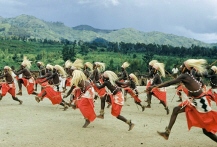
Typical street scene in Santa Ana, El Salvador. (Photo: iStock)
IMF Survey: Congo's Debt Burden Lightened
March 22, 2010
- IMF and World Bank approve $1.9 billion in debt relief
- Resources freed up to support growth and social policies
- IMF calls for continued structural reforms and diversification of economy
In January 2010, the IMF and World Bank approved debt relief for the Republic of Congo of $1.9 billion, freeing up badly-needed resources for health, education and other social services.

Congolese warriors performing a mock charge. The Congolese government, with IMF help, have been attacking debt. (Moore/National Geographic/Corbis)
DEBT RELIEF
The decision will reduce Congo’s debt burden by 34 percent and was reached after the country met a series of rigorous conditions under the enhanced Heavily Indebted Poor Countries (HIPC) Initiative. Having reached the HIPC completion point, Congo has now qualified for debt relief under the Multilateral Debt Relief Initiative (MDRI).
"The conditions for reaching the completion point under the HIPC Initiative were set very high for Congo. The intention was to support the authorities’ efforts to prioritize public expenditures, firm up public financial management, combat corruption, and bolster governance and transparency in the management of its oil resources,” said the IMF’s mission chief for Congo, Robert York.
“The HIPC completion point clearly demonstrates that the authorities are determined to lay a firm foundation for enhancing growth and reducing poverty, which is very encouraging,” he added.
From war to recovery
The granting of debt relief marks a significant milestone in Congo’s path towards recovery following a devastating civil war. Despite its wealth in natural resources and fertile land, Congo has suffered years of stagnation, with the civil war blunting capacity and hampering economic management. In 2000, per capita income in real terms was only around 70 percent of what it had been 20 years earlier.
Following the end of the civil war and the establishment in 2002 of Congo as a republic, a new government was elected into office. Since then, successive governments have been rebuilding the institutional and administrative capacity needed to implement sound macroeconomic policies and structural reforms.
Relations with the Fund
Against this background, Congo has also been strengthening its ties with the IMF. In 2004, it signed on to a three-year Poverty Reduction and Growth Facility arrangement with the IMF, but weaknesses in capacity resulted in uneven program performance under this arrangement. In March 2006, the country qualified for HIPC and MDRI debt relief with very difficult conditions set by the Executive Boards of the IMF and the World Bank.
These were designed to demonstrate a commitment to poverty reduction and a good track-record of economic management, the strengthening of public financial and resource management, governance and transparency.
In a bid to establish a track record of solid economic management, the IMF and the authorities reached agreement on several staff-monitored programs, with the authorities taking on greater ownership over time. In 2007, the government created a Policy Committee, headed by the President, and a Technical Committee, headed by a special advisor to the president. The responsibility of these committees was to oversee economic programs, and put in place the reforms required to strengthen relations with the Fund and the World Bank.
In December 2008 the Fund’s Executive Board approved a new three-year Extended Credit Facility (ECF, formerly the PRGF) program for Congo. This helped pave the way for Congo to reach the HIPC completion point.
Persevering through difficult times
Brazzaville’s performance under the ECF and HIPC framework has been threatened by domestic political and global developments including a presidential election in 2009, the global financial crisis which suppressed external demand, and a plunge in world oil prices which reduced Congo’s oil revenue by about a third. But the authorities persevered and despite the turbulence, by the end of 2009, Congo had made some significant achievements:
• The basic non-oil primary fiscal deficit was reduced to around 37 percent of non-oil GDP.
• Public financial management and tax and customs administration were strengthened, and a strategy for deepening financial intermediation was under implementation
• All 18 HIPC “floating completion point triggers” or conditions were successfully met, covering a range of areas, including satisfactory implementation of the authorities’ Poverty Reduction Strategy, improving conditions in some social sectors, better management of external debt, prioritizing public spending, addressing corruption, enhancing oil sector governance, and revenue transparency.
Unfinished business
The debt relief will increase Congo’s ability to spend money on health, education, and other social services, including moving towards the Millennium Development Goals.
But Congo still faces considerable challenges ahead: oil production is expected to decline over the next few years and structural reform is urgently needed to diversify the economy and reduce its dependence on this commodity. Congo needs to manage debt better: borrowing more conservatively and further consolidating its fiscal position to avoid falling back into debt distress.
The republic also needs to continue raising the quality of its spending by making sure it adheres to its newly established medium-term expenditure framework, public-investment program, and poverty reduction strategy. Finally, Congo needs to ensure that recent efforts to bolster oil sector governance and commercialization yield the highest possible returns to the people of Congo.
Comments on this article should be sent to imfsurvey@imf.org









